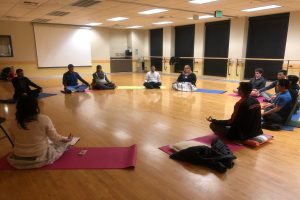Hot Yoga is Superior in Improving Cardiovascular Health
By John M. de Castro, Ph.D.
“It might be hard, but hot yoga can help improve strength, flexibility and balance, while helping decrease your risk of conditions such as diabetes and heart disease.” – Lydia Stephens
Cardiovascular disease is the number one killer, claiming more lives than all forms of cancer combined. “Heart disease is the leading cause of death for both men and women. About 610,000 people die of heart disease in the United States every year–that’s 1 in every 4 deaths. Every year about 735,000 Americans have a heart attack.” (Centers for Disease Control). A myriad of treatments has been developed for heart disease including a variety of surgical procedures and medications. But the safest effective treatments are lifestyle changes. These include quitting smoking, weight reduction, improved diet, physical activity, and reducing stresses. Other safe and effective treatments are contemplative practices, such as meditation, tai chi, and yoga, have also been shown to be helpful for heart health. These practices have also been shown to be helpful for producing the kinds of lifestyle changes needed such as smoking cessation, weight reduction, and stress reduction.
Yoga is a mindfulness practice and exercise that has been shown to improve physical well-being and cardiovascular health. Hot Yoga is somewhat unique yoga practice as it is practiced in a heated environment (105°F, 40.6°C, 40% humidity). The hot environment is thought to soften the muscles making them more pliable and loosen the joints making them more flexible allowing the practitioner to go deeper into poses. The sweating that occurs is thought to help remove toxins and impurities. It is not known if hot yoga is better in improving cardiovascular health than regular yoga.
In today’s Research News article “Cardiovascular, Cellular, and Neural Adaptations to Hot Yoga versus Normal-Temperature Yoga.” (See summary below or view the full text of the study at: https://www.ncbi.nlm.nih.gov/pmc/articles/PMC8191229/ ) Bourbeau and colleagues recruited adults and randomly assigned them to either practice normal yoga or hot yoga for 75 minutes 3 times per week for 4 weeks. Both normal and hot yoga sessions followed an identical taped standardized yoga program. The participants were measured before and after training for body size, maximal aerobic capacity (VO2Max), heat tolerance, and perceived stress. In addition, blood was drawn and assayed for adrenocorticotropic hormone, brain-derived neurotrophic factor, and heat shock protein 70.
They found that in comparison to baseline the hot yoga group had significant increases in maximal aerobic capacity (VO2Max) and heat shock protein 70, while the normal yoga group did not. Both yoga groups had significant increases in brain-derived neurotrophic factor. Neither yoga practices significantly altered plasma adrenocorticotropic hormone, perceived stress, or heat tolerance.
These results suggest that practicing yoga in a hot environment increases its ability to improve cardiovascular fitness (VO2Max) and cellular heat tolerance (Heat shock protein 70). Yoga in either form increase brain development (Brain-derived neurotrophic factor). This suggests for adult patients at risk for or having cardiovascular problems who can also tolerate high temperatures that hot yoga may be an effective treatment to improve cardiovascular function. The results also show as has been shown in multiple previous studies that yoga practice improve the physical well-being of the participants.
So, hot yoga is superior in improving cardiovascular health.
“hot yoga promises a number of compelling health benefits, alleging to cure everything from back pain to high blood pressure to anxiety.” – Anna Dickens
CMCS – Center for Mindfulness and Contemplative Studies
This and other Contemplative Studies posts are also available on Google+ https://plus.google.com/106784388191201299496/posts and on Twitter @MindfulResearch
Study Summary
Bourbeau, K. C., Moriarty, T. A., Bellovary, B. N., Bellissimo, G. F., Ducharme, J. B., Haeny, T. J., & Zuhl, M. N. (2021). Cardiovascular, Cellular, and Neural Adaptations to Hot Yoga versus Normal-Temperature Yoga. International Journal of Yoga, 14(2), 115–126. https://doi.org/10.4103/ijoy.IJOY_134_20
Abstract
Context:
Chronic heat exposure promotes cardiovascular and cellular adaptations, improving an organism’s ability to tolerate subsequent stressors. Heat exposure may also promote neural adaptations and alter the neural–hormonal stress response. Hot-temperature yoga (HY) combines mind–body exercise with heat exposure. The added heat component in HY may induce cardiovascular and cellular changes, along with neural benefits and modulation of stress hormones.
Aims:
The purpose of the present study is to compare the cardiovascular, cellular heat shock protein 70 (HSP70), neural, and hormonal adaptations of HY versus normal-temperature yoga (NY).
Settings and Design:
Twenty-two subjects (males = 11 and females = 11, 26 ± 6 years) completed 4 weeks of NY (n = 11) or HY (n = 11, 41°C, 40% humidity). Yoga sessions were performed 3 times/week following a modified Bikram protocol.
Subjects and Methods:
Pre- and posttesting included (1) hemodynamic measures during a heat tolerance test and maximal aerobic fitness test; (2) neural and hormonal adaptations using serum brain-derived neurotrophic factor (BDNF) and adrenocorticotropic hormone (ACTH), along with a mental stress questionnaire; and (3) cellular adaptations (HSP70) in peripheral blood mononuclear cells (PBMCs).
Statistical Analysis:
Within- and between-group Student’s t-test analyses were conducted to compare pre- and post-VO2 max, perceived stress, BDNF, HSP70, and ACTH in HY and NY groups.
Results:
Maximal aerobic fitness increased in the HY group only. No evidence of heat acclimation or change in mental stress was observed. Serum BDNF significantly increased in yoga groups combined. Analysis of HSP70 suggested higher expression of HSP70 in the HY group only.
Conclusions:
Twelve sessions of HY promoted cardiovascular fitness and cellular thermotolerance adaptations. Serum BDNF increased in response to yoga (NY + HY) and appeared to not be temperature dependent.
https://www.ncbi.nlm.nih.gov/pmc/articles/PMC8191229/









